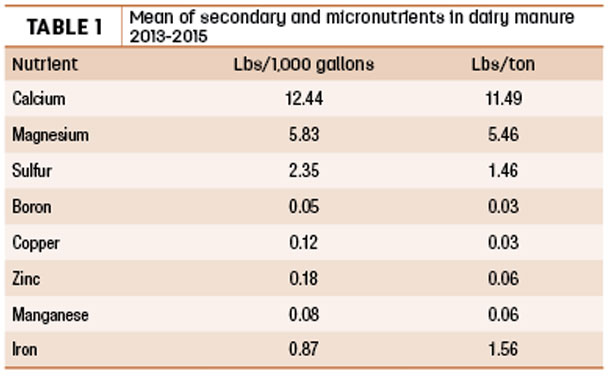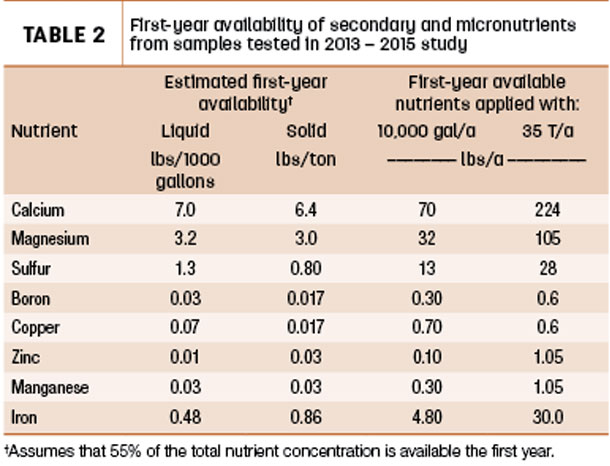In the past, manure was thought of as a waste and hauled to the field at the expense of the livestock industry. Manure becomes a valuable resource when a farmer credits the nutrients from a manure application, which contributes to the sustainability of the farm by reducing purchased fertilizer.
Manure’s value is based on the current cost of commercial nitrogen, phosphorus and potassium fertilizer, which the manure application will replace in the first year after an application.
Manure also supplies secondary and micronutrients. There is an increasing interest in knowing the secondary and micronutrient content of dairy manure.
From 2013 to 2015, the University of Wisconsin Extension Nutrient Management Team, in conjunction with the University of Wisconsin Soil and Forage Analysis Lab in Marshfield, randomly selected 100 dairy manure samples submitted from across Wisconsin for analysis of total secondary and micronutrient content.
Liquid manure samples were characterized as having a dry matter content less than or equal to 11 percent. Samples with more than 11 percent dry matter were considered solid manure. Of the 100 manure samples, 65 were liquid, and 35 were solid.
One note: There was variability in the manure samples from year to year, and one factor contributing to variability is rainfall, which was very low in 2012 and about average in 2013 and 2014. Samples were collected in the fall, analyzed, and data was tabulated the following year.
First-year availability of micronutrients is dependent on a particular nutrient’s interaction with the organic matter and clay fractions present in the soil, along with the release of nutrients as soil micro-organisms aid in manure decomposition.
The mean of secondary and micronutrient content in the dairy manure samples is provided in Table 1.

A 90 percent confidence interval was calculated from the data, and analysis of the data provides reliable numbers to determine:
1. Available secondary nutrients and micronutrients in dairy manure
2. Additional economical value to dairy manure beyond nitrogen, phosphorus and potassium
Because samples were randomly selected from manure samples submitted to the lab, detailed information regarding manure storage, bedding and dairy diet are unknown. As such, it is not possible to attribute specific reasons for differences in nutrient concentrations.
Not all of the secondary and micronutrients in dairy manure are available to a growing crop in the first year. Approximately 55 percent of the total concentration of secondary and micronutrients is available in the first year after application.
When dairy manure is applied on a field in consecutive years, there may be a higher level of secondary and micronutrients available to the growing crop, as soil microbiology will release nutrients from the previous year’s application of organic material (manure).
A typical dairy manure application should provide the required secondary and micronutrients that may be deficient for most field crops (Table 2), with the exception of sulfur and boron.
 Typically, farmers will apply about 100 pounds of nitrogen per acre as a manure application. The amount of sulfur applied with 10,000 gallons per acre of liquid or 35 tons per acre of solid dairy manure may fall a little short of the annual sulfur requirement for alfalfa and corn silage.
Typically, farmers will apply about 100 pounds of nitrogen per acre as a manure application. The amount of sulfur applied with 10,000 gallons per acre of liquid or 35 tons per acre of solid dairy manure may fall a little short of the annual sulfur requirement for alfalfa and corn silage.
On sandy soils, boron is often applied annually to alfalfa at a rate of 1 pound of boron per acre, as manure applications may not supply enough boron for alfalfa.
Table 2 presents the estimated first-year availability.
With proper management, secondary and micronutrients will reduce fertilizer purchases. What is that worth? That is $4 for 1 ton of solid dairy manure and $5 per 1,000 gallons of liquid dairy manure. Based on the 100 pounds per acre of nitrogen manure application, this would be a fertilizer savings for secondary and micronutrients of $140 per acre for solid manure and $50 per acre for liquid manure.
In summary, dairy manure’s value is based on the macronutrients provided by an application, thus replacing commercial fertilizer. In addition, dairy manure will supply secondary and micronutrients required by most field crops, with a possible exception for sulfur and boron.
Crediting macro-, secondary and micronutrients available in a dairy manure application will reduce commercial fertilizer purchases. The result of nutrient management crediting will allow the farm to be sustainable and environmentally sound. ![]()
PHOTO: Spreading manure in a field. Photo by Getty Images.
References omitted but are available upon request. Click here to email an editor.

-
Richard Halopka
- Clark County Crops and Soils Agent
- University of Wisconsin Extension
- Email Richard Halopka






